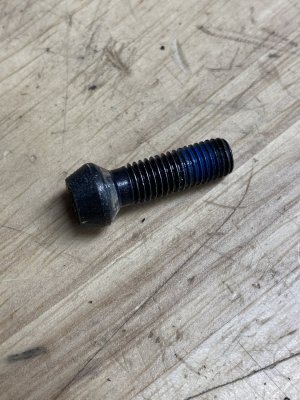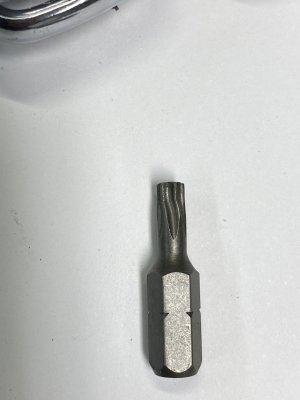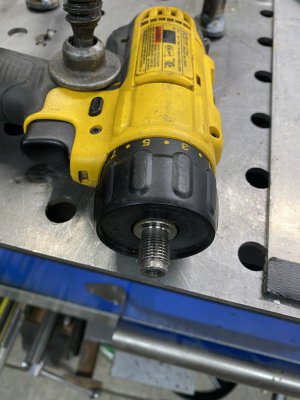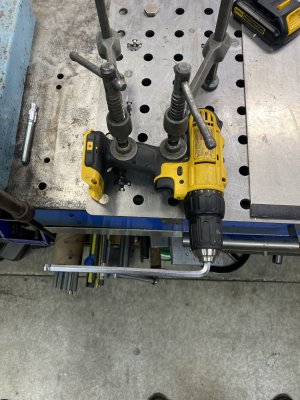- Joined
- Mar 26, 2018
- Messages
- 8,760
Wow,From the factory those things are set up right tight, and for obvious reason. Indeed, the "inside" screw is going to be a left hand thread, and the chuck it's self is going to be a right hand thread. Removing either can be brutal. About 4000 Youtube videos might build your confidence a bit.....
Don't go spraying oil... The inside screw, clean metal to clean metal, has formed a seal. Oil won't get under it until AFTER you find a way to loosen it. It's not really every day, but I've worn out my share of drill chucks... The "original" way since threaded chucks were a thing, is clamping a3/8 allen key in the chuck, and beating the (tar) out of it with a hammer to get it to turn (Seriously, I wasn't joking, it takes 4000 Youtube videos to build up that kind of confidence). I've evolved that into using a 3/8 impact gun, clamping a 3/8 square drive allen key in the chuck. That is a quick speedy, not huge torque impact gun. Couple hunnert pounds rated maybe. NOT the big ugga dugga.....
First step for a reversable drill with the locking screw inside, put the allen key in the in the dill chuck and TIGHTEN it with a good hammer thwack, or a couple of burps on the impact gun. This ensures it's not "locked" against the locking screw.
Second step, take your torx socket that you're using to remove the locking screw, put it in the screw, and close the existing chuck until it's supporting but NOT CLAMPING the socket. Just supporting it, minimal play. Now, hold the drill by the chuck, over the work bench, but above it, so you're ONLY supporting the drill with your hand, and only by the chuck, Then, a couple of good sharp hammer thwacks on top of the driver. You're using the driver like a nail set to drive that screw home....
Third step... Go back to the removing of the locking screw as you normally would. Start gently and escalate slowly. If it gets to where it's just not gonna go, no way, no how... Use that torx head on the screw as a pilot, and drill the head off.
Fourth step, go back to what I said before, and allen socket and a small impact wrench, or the allen key and the BFH to unscrew the chuck.
Fifth step, if there's a drilled off stump of locking screw in there, because you excercised restraint and drilled it before it broke..... There's a little tiny stump sticking up. If it's not locktited, it's unloaded, it'll come out by hand. (They always loctite 'em...). Or You can safely warm the "spindle" enough to soften the loctite that's got it stuck in there, and pliers will unscrew it. It is a left hand thread.
As for the new chuck that you're gonna get- I'm not going to be a huge help here, except to temper your expectations. The old drill chucks of days gone by that would clamp so tight they'd put their own three flats on a round drill.... Those days are gone. Materials and batch production processes have made drills harder (not as hard as the business end, but harder), and the drill motors themselves, they have so much more torque than the same thing from years gone by... It's an apples to oranges comparison to the drills that were equipped with the chucks we all remember, that were faultless at the time. That said, there are some better and some worse. OK, yeah... The big old all metal drills that weighed ninety pounds, had no torque, but thirty pounds of motor and gear reduction all in rapid motion... They won't hold a modern drill bit either. You'll never wear the (keyed) chuck out, but it won't hold the bit. Find a drill bit as old as the drill, and you're back in business (until you break your arm), but they don't like modern bits either.
So... Basically, your drill chuck is going to be fairly flat backed, although there's a very good "counterbore" before the threads start, which makes it kinda particular, but pretty well out there in all the usual places. Grainger, Mcmaster, MSC, Shars, etc. The bad thing is this. If you want a GOOD drill chuck... It's out of your price limit
Everybody has their own accounting system, I'd have a hard time spending past half of that number for a "decent" chuck... Personally, I'd be inclined to look into an old timey keyed chuck. (And did on one of my drills of another brand). They're not keyless, and the "keeping track of the key" habit takes a couple of searches around the shop to become ingrained into muscle memory again, but you won't be bracing the drill between your legs and yarning on the keyless chuck with channel locks any more... Fair swap for me. Probably not for everybody, but at least worth "considering" in the mix, given what's out there.
Thanks. Lots of information here.
I need to go buy some more T20 bits first, three down




